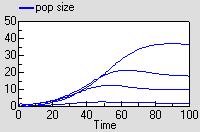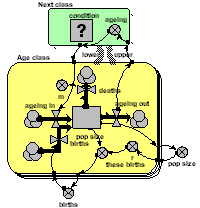Main menu
You are here
Model gallery : age-class disaggregation
Population age-class models
Explicit compartments
The simplest way of making an age-class model is to have a separate compartment for the number in each class. The compartments are connected by flows representing the movement of animals between classes as they age. Reproduction feeds into the first class, and all classes have a mortality outflow. This particular model includes density-dependent reproduction.
The model eventually equilibrates with a fixed number in each class.


Multiple-instance submodel
In this model, each age-class is now one instance of a fixed-membership, multiple-instance submodel. It has a compartment (the number in that each class), and associated flows. Outside the submodel we have an array for transferring those leaving one class to the next class, an array for the births from each class, and a variable for total population size.
Running the model produces exactly the same results as for the previous model, though this time the results are shown for each instance of one variable.


Multiple-instance submodel with an association between classes
Again, a multiple-instance fixed-membership submodel is used to represent each age-class. But in this model the transfer of individuals from one class to the next takes place through an association submodel, defined in terms of the relationship between one class and the next. This is a more expressive, flexible and (for complex models) more efficient way of linking classes.
The results are excatly the same as for the previous model.


- Printer-friendly version
- Log in or register to post comments
